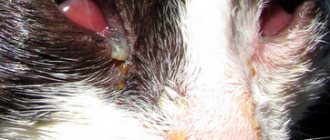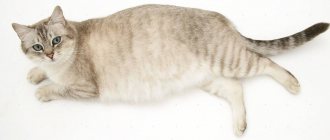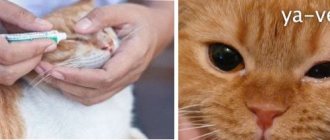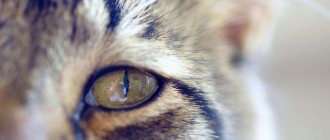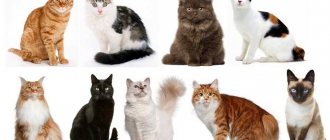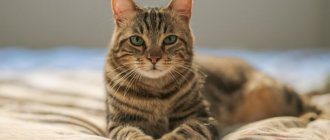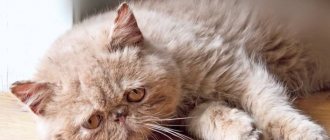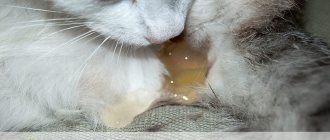If this is your first time encountering the fact that your cat has brown discharge from the eyes, you probably don’t know what to do. Now there are many folk methods of combating and preventing diseases of our pets, and pharmacies offer a huge range of medications.
Following the advice of friends, you can easily make a mistake and harm your pet. After all, what your friend used to treat her rabbit when his eyes were watery is unlikely to be suitable for a cat.
This article will help you determine the type of disease and choose a method for its treatment and prevention.
Types of discharge
Each type of opaque liquid indicates the presence of health problems. The darker the color of the discharge, the more serious the animal’s illness.
Normal discharge
Healthy cats may produce a thin, clear secretion. It usually clears any dust or debris from the eyes. Also, after sleep, liquid or jelly-like droplets may accumulate in the corners of the eyes. The cat removes them herself while washing.
Another secretion can be released as a defensive reaction in bright light, strong odors or smoke. Once you eliminate the factor, the cat's eye condition will be restored.
Liquid transparent discharge
Uncontrollable discharge, when the eyes begin to water, does not indicate anything dangerous. Most likely this is an allergic reaction.
White discharge
White mucus-like substance is a sign of a viral infection. May be a symptom of conjunctivitis or eyelid lesions. At this stage, treatment should begin.
Yellow discharge
They may also have a greenish tint. Indicate the presence of pus. This is a symptom of a bacterial infection, which may be accompanied by a deterioration in the cat's general health. The temperature often rises, there is no appetite, and nausea begins.
Brown discharge
The color indicates the presence of blood in the fluid. Dark discharge from a cat's eyes is a symptom of an acute infectious eye disease. May be bloody or black.
What breeds may have eye problems?
It is normal for British, Scottish and Persian cats to have watery eyes. This is mainly due to long hair that irritates their eyes or short tear ducts. In Persians, this is aggravated by the structural features of their bulging eyes.
Don't forget that cats, like people, can have watery eyes in the morning for no reason. These are the so-called “morning tears”. Another important factor is the young age of the kittens; they may not be able to wash themselves well enough. In this case, they need your help - just wipe their eyes with a damp cotton pad.
Secondly, keep track of how often and in what quantity the tears flow? If you accidentally notice them, this is the first time and your pet is not worried at all, then this may be an allergic or other one-time reaction. In this case, it will be enough to rinse your eyes and strengthen your care for a while.
Causes
If your cat has brown discharge from the eyes, it is always a sign of health problems, but it is not always caused by an infection.
Non-infectious causes
These are congenital pathologies, hereditary diseases or acquired characteristics due to injury.
- Features of the anatomical structure of the eyelids.
Anomalies can be congenital or acquired. Typically, the eyelashes come into contact with the cornea. An example of such an anomaly is entropion of the eyelids. Also, impaired eyelash growth causes irritation of the tear duct.
- Third century injuries.
May be caused by a fall or impact. As well as injuries to the nose or facial part of the skull.
- Tear duct defects
Pathologically narrow lacrimal canals or congenital obstruction of the ducts.
My cat's eye is watering, what should I do?
There are situations when both experienced owners and beginners wonder: the cat’s eye is watering, what should I do? The causes of this problem and methods of treatment can be very different. You can remove some of the factors that trigger lacrimation yourself. In other cases, the help of a veterinary ophthalmologist or epidemiologist (specialist in infectious diseases) will be required.
Why are tears needed and where do they come from?
Mammals' eyes were inherited from waterfowl ancestors and are designed in such a way that they can work if their surface is dry. There are no problems with this in the sea, but on land the lacrimal glands, which constantly produce liquid, are responsible for hydration.
A passage begins in the corner of the eye that leads into the nasal canal and tears flow down it. We can say that the cat's eye is constantly watering.
The system works much like a bathtub drain: if the plug is open and the water flow is not too empty, the bathtub appears empty, but water flows through it.
Causes of excessive tears
Tears outside the eye appear for two reasons: if tears are produced in excess or if the outflow is impaired.
Most often, a cat's eye waters because the nasolacrimal duct is blocked.
Causes of obstruction of the lacrimal duct:
Infectious and inflammatory processes in the mucous membranes of the eyes, eyelids and
nasopharynx. The inflamed mucous membrane swells, becomes thicker and mechanically blocks the exit from the eye. This can happen with conjunctivitis, blepharitis, and rhinitis, both infectious and non-infectious. Blockage of the nasolacrimal duct. Cats can get a variety of things into their noses, from dust to insects. They block the channel, as a result the cat’s eye waters - the “bathtub” overflows.
Curvature and narrowing of the nasolacrimal duct. This is usually a congenital phenomenon and often occurs in cats with a depressed muzzle profile (Persian, Himalayan). The canal can become bent even after injuries in the area of the nose and cheekbone, and then the cat’s eye constantly waters. Such changes are usually incurable
Excess tears appear if:
Something got into my eye.
Symptoms
The following information will help you recognize some common illnesses at home.
Conjunctivitis
Infection occurs through contact. It can be identified by swollen eyelids, redness of the eyes and purulent discharge. If the discharge from the eyes of cats is brown, it means that the disease is already advanced.
Conjunctivitis is treated with medications: you can wash your eyes with an antiseptic or chamomile decoction, it relieves inflammation well. Then apply an antimicrobial ointment, such as Tetracycline, to the eye. In severe cases, injections into the conjunctiva may be necessary.
Blepharitis
It is an infection that has entered the hair follicles of the eyelashes. It may appear due to low immunity, infection in the eyes, or general weakening of the body. It is identified by inflamed eyelids, and dark grayish fluid may accumulate in the corners of the eyes.
When the disease is advanced, ulcers form on the inside of the eyelids, and the secretions become brown or dark.
In such a case, first of all, it is necessary to increase immunity and treat the eyelids with an antiseptic or chamomile. In severe cases of the disease with black discharge, hormonal ointments are used.
Keratitis
Damage to the cornea of the eye occurs most often due to damage to the surface of the eye. In advanced cases, a purulent ulcer appears.
Dark discharge from your cat's eyes will accumulate in the corners.
For treatment, a whole set of antibacterial, antiviral, antihistamine and other drugs are used, as prescribed by the doctor.
Iridocyclitis
With this disease, the iris becomes inflamed. It can be caused by a virus, bacteria or fungus. You can recognize it by photophobia, pain and redness of the eyes.
In advanced cases, there will first be purulent discharge, and then bloody or black. The iris of the eye may change color.
If the disease lasts for a long time or treatment is ineffective, vision can be severely damaged. For treatment, detoxification and antiviral drugs are used as prescribed by the attending physician.
REMINDER before going to the veterinarian
- When did the tears first appear and when did they begin to bother the cat?
- Both eyes were affected at once or one after the other;
- What kind of discharge?
- What has the cat eaten over the past few days?
- When was the last time you had a vaccination, treatment or surgery;
- Are there any other symptoms?
Below we will discuss in more detail the possible causes of watery eyes in cats and the necessary treatment. IMPORTANT: Remember that only a veterinarian can make an accurate diagnosis after you have taken and waited for the tests. Therefore, if possible, do not delay going to the doctor.
Washing
It takes two people to help a cat with watery eyes. Holding it tightly and at the same time carefully rinsing the eye alone will not work.
For the procedure, make any antiseptic solution without alcohol: you can take furatsilin, chamomile or oak bark. The liquid should not be hot and slightly concentrated.
One person should hold the pet firmly to prevent it from twitching. You can take her on your lap: if it is the owner, the cat will smell him and calm down. Hold her paws with one hand and hold her head with the other.
The second person will need a gauze swab or cotton pad and a prepared warm solution. Soak the swab in the broth and squeeze it out lightly, then gently rub it over the animal’s eye. Make sure your cat is not in pain from this procedure, especially if she is bleeding.
Repeat wiping until the new swab is clean.
If your cat's eyelids are stuck together due to the amount of discharge, then you can apply an unwrung swab to the eye and leave it for a while. Warm liquid will quickly help the eye open, and after that you can rinse the eye.
After the procedure, you can put tetracycline ointment under the eyelid. It will help relieve inflammation and make the cat feel a little better.
It is important to know
The decision of how and with what means to wash a cat’s eyes depends on the specific case. It is necessary to take into account the reason for which it was necessary to clean the eyes, as well as the individual reaction to any component in the composition of the drug.
If lacrimation is excessive
You can rinse your eyes with clean distilled water, but it is better with saline solution (with a salt concentration of 0.85%). This procedure will also help in removing dust, pollen, hairs and other small foreign bodies. If your pet has allergies, this method is the best.
If your eyes fester
In case of purulent exudate from the eyes or their sticking together (this happens after a while, when dry crusts appear), you need to drip the eyes with special antibacterial drugs, which are purchased at a veterinary pharmacy. This is necessary because pus is a symptom of infection.
Chlorhexidine for eye rinsing
Veterinarians do not agree on this issue, but the majority believes that it is possible. But you need to use chlorgesidine with a concentration of no more than 0.01%, then the use will be harmless.
Cleansing with furatsilin
Furacilin solution must be used with a concentration of maximum 0.02%, and the drug must also be sterile
It is important to know about possible individual intolerance to the substance; if it exists, then the use of furatsilin is prohibited
Prevention
By nature, a cat is capable of independently caring for itself and its health. If your pet leads a clean lifestyle, and his eyes begin to become inflamed, then the source of the infection is in your home. The exception is when the animal has free access to the street.
In any case, if there are animals in the house, frequent and thorough cleaning is necessary to avoid introducing infection into the body of your pets.
If for some reason the cat is not able to clean its eyes and face on its own, then this concern falls on your shoulders. Veterinary stores sell special lotions to clean the eyes of animals. They need to be used daily.
A real owner takes great care of his pets. He takes them to all the necessary vaccinations, prevents various diseases and monitors the cleanliness of the house.
Follow our advice, and your pets will have excellent health!
This article has been checked and approved by a veterinarian. Knyazeva Anna Vladimirovna, veterinarian in private practice, Moscow. more about the expert.
(you can vote for the article)
Tags: cat discharge, cat health, cat
- Related Posts
- What to do if your cat has a stuffy nose?
- TOP 7 vitamins for pregnant and lactating cats
- The cat is tearing up the wallpaper: what to do?
How to help a cat
Only a veterinarian can determine exactly why a cat’s eyes are watering. What to do if it is impossible to get to him right away? If there is a suspicion of conjunctivitis, the eyes are washed with a solution of furatsilin or a solution of levomecithin is instilled into them. An antibiotic ointment will prevent infection. Injections of a solution of hydrocortisone and novocaine will reduce pain. If your pet has allergies, a drug based on hormones will help.
If you notice that your cat often has watery eyes and there are accompanying symptoms, you should immediately contact your veterinarian. If they cannot accept your pet right away, you need to provide him with first aid in accordance with the symptoms.
VETERINARIAN CONSULTATION REQUIRED. INFORMATION FOR INFORMATION ONLY.
Sometimes cat owners notice that their pet's eyes begin to water. This symptom occurs because lacrimation is a protective reaction to external or internal irritants. In some cases, it may be a variant of the norm, but most often it indicates the presence of some pathological process.
There are physiological and pathological lacrimation. The first refers to the accumulation of a small amount of dried tear fluid in the corners of the eyes. It looks like brown or brown-brown crusts. Occurs for a number of reasons:
- Age.
In small kittens, in the first days of life, the organs of vision are still closed. When they erupt, tears flow profusely, which is considered a natural process and lasts no longer than a week. To prevent infection, it is recommended to rinse your pet's eyes with warm, clean water. - Hair getting into the eye.
Often found in long-haired breeds. - Irritation.
When dust, tobacco smoke and some other substances come into contact with the mucous membranes of the eyes. - Predisposition.
A similar sign is often found in Scottish, British, Persian and some other breeds. - Dry air.
- Dream.
The release of a small amount of tears after sleep is considered normal.
In all of the above cases, the pet’s health remains normal. No hygienic or therapeutic procedures are required.
Pathological lacrimation is observed in almost any eye disease. The animal experiences noticeable discomfort and may sneeze, squint and rub its eyes with its paws.
- . It bends in the other direction, the mucous membrane is irritated by hair and eyelashes.
- Chemical and thermal burns.
- Entry of a foreign body.
- Viral respiratory diseases (calicivirus or herpesvirus infections). At first the discharge is clear and mucous, but later becomes purulent. Other characteristic symptoms are also present: poor appetite, lethargy, nasal discharge, sneezing.

